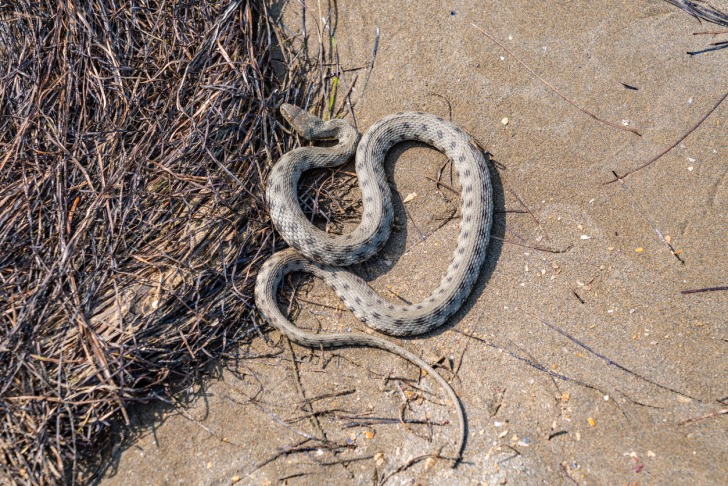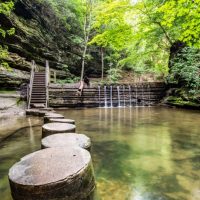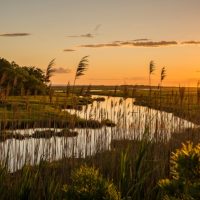North Carolina boasts a diverse snake population of 37 species, from the vibrant Eastern Coral Snake to the formidable Timber Rattlesnake; all play crucial roles in the state’s ecosystems.
While some, like the harmless Eastern Garter Snake, are found in urban areas, others, like the Copperhead, are found (but only by stealth) in the state’s wild topography and terrain.

Contents
So… Are There Snakes in North Carolina?
Yes, the Tar Heel State is proud to host 37 species of snakes in North Carolina.
Most Common Snakes in North Carolina
Some common snakes include the Eastern Garter Snake, Black Racer, Eastern Rat Snake, and Northern Water Snake.
Most Dangerous Snakes in North Carolina
Venomous species include the Copperhead, Timber Rattlesnake, Pigmy Rattlesnake, Cottonmouth, Eastern Diamondback Rattlesnake, and Eastern Coral Snake.
However, remember that snakes play a critical role in nature’s ecosystems, and most snake species aren’t venomous and don’t pose a threat.
If you see a snake, observing and allowing it to move away is best.
A Roll Call of the 37 Species of North Carolina Snakes
Discover a range of fun, homey, and descriptive vernacular snake names:
- Eastern Diamondback Rattlesnake
- Timber Rattlesnake
- Copperhead
- Cottonmouth
- Eastern Coral Snake
- Eastern Garter Snake
- Eastern Ribbon Snake
- Eastern Rat Snake
- Eastern Coach Whip
- Eastern Worm Snake
- Black Racer
- Northern Water Snake
- Red-bellied Snake
- Rough Green Snake
- Smooth Green Snake
- Eastern Hognose Snake
- Eastern King Snake
- Scarlet Snake
- Eastern Worm Snake
- Brown Snake
- Eastern Mud Snake
- Queen Snake
- Corn Snake
- Pine Snake
- Northern Scarlet Snake
- Eastern Smooth Earth Snake
- Eastern Fox Snake
- Southeastern Crowned Snake
- Eastern Indigo Snake
- Eastern Coral Snake
- Eastern Garter Snake
- Eastern Ribbon Snake
- Eastern Rat Snake
- Eastern Coachwhip
- Eastern Worm Snake
- Black Racer
- Northern Water Snake

Is it Safe to Go on a Trek in North Carolina?
North Carolina is famous for its scenic beauty and outdoor recreation opportunities.
However, it’s critical to take precautions against potential dangers.
Being prepared and mindful of your surroundings is the basis of a safe and fun hiking experience.
While snakes are a concern, there are other elements to consider, including:
- Animals, Wild & Mild: North Carolina’s diverse wildlife includes black bears, coyotes, and deer.
While encounters are rare, stay cautious.
Store food securely, and keep a safe and respectful distance.
You’re in the animals’ hood now.
- Ticks: Tick-borne illnesses are a concern in wooded areas.
Use insect repellent with DEET, wear long sleeves and pants, and do regular tick checks.
Plus–you’ll want to be mindful of spiders, bees, and other insects.
- Terrain: North Carolina includes mountains, forests, and water bodies.
We’re lucky like that, but hikers will want to prep for uneven terrain, slippery surfaces, and rapidly changing weather.
Trails may have steep inclines, rocky surfaces, or cliffs.
Stay on marked paths, and be cautious near cliffs.
(No selfie’s worth it).
- Weather: Weather can change quickly, especially in the mountainous.
Check the forecast, and be prepared for rain, wind, or sudden temp drops.
Dress in layers; bring appropriate gear.
- Dehydration and Hypothermia: Carry enough water to maintain hydration.
Be aware of the risk of hypothermia in colder months, and dress appropriately.
- Navigation/Communication: Know the trail.\
Carry a map or fully charged phone/GPS device.
In emergencies, make sure you have a means of communication.
And know your nearest exit points.
- Snake!: Snakes play a vital role in the ecosystem.
Yes, some are venomous, so visitors should be cautious, especially in warmer months when snakes are more active.
Stay on marked trails, avoid reaching into areas you can’t see, and wear appropriate footwear.
Interesting Snake Facts in North Carolina
- Venomous: North Carolina’s home to six venomous snake species, including the Cottonmouth, Timber Rattlesnake, Pigmy Rattlesnake, Copperhead, Eastern Diamondback Rattlesnake, and Eastern Coral Snake. Awareness of their habitats and taking precautions in snake-prone areas is essential.
- Copperhead. An Abundance of Copperheads: The Copperhead is one of the most typically run into venomous snakes. Its distinctive appearance, with a copper-colored head, makes it recognizable.
- Diversity: North Carolina boasts diverse snake species, from harmless and colorful garter snakes to more giant constrictors like the Eastern Rat Snake, with snakes inhabiting mountains and coastal areas.
- Conservation Efforts: The decline of some snake species in North Carolina has led to conservation initiatives that seek to protect habitats and raise awareness about the importance of snakes in ecosystems.
- Location, Location, Location: Snakes in North Carolina show diverse behaviors. Some are arboreal, like the Eastern Rat Snake, while others are expert swimmers, like the Cottonmouth.
- Snakes in an Ecosystem: Snakes are crucial in controlling rodent populations and maintaining ecological balance. (Understanding and appreciating their significance is vital for conservation efforts.)
3 Safety Tips for Exploring Nature in North Carolina
Exploring North Carolina’s scenic outdoors is a fantastic experience, yet focusing on safety is crucial–remember:
Trail Preparedness
Research Trails: Research your trail. Know its difficulty level, length, and possible hazards.
Pack Essentials: Water, snacks, a map, compass/GPS device, and first aid kit.
ETA: Tell somewhere where you’re going and the estimated return time.
Wildlife
Objects in the Mirror are Closer than They Appear: Visitors should observe wildlife from a safe distance and avoid feeding/approaching.
This lowers the risk of annoying the animals and protects you.
Familiarize yourself with the local flora and fauna, including snakes.
Picnicking?: Store your food securely to avoid attracting animals (other than your friends).
Please dispose of your trash properly.
Prep for the Weather
True, North Carolina’s weather can be unpredictable. So you have a choice here: be prepared by monitoring weather forecasts and bringing rain gear–or don’t.
Summary
These fascinating slithering serpents’ diversity and ecological significance add to the harmonious relationship with these fascinating creatures in North Carolina’s unique landscapes.
Snakes in North Carolina?
The Tar Heel State is proud to be home to 37 species, including venomous slithering snakes such as the Eastern Diamondback Rattlesnake, Copperhead, Timber Rattlesnake, and Cottonmouth.
You’ll run into some snakes regularly, while others, like the Eastern Indigo Snake, are federally protected as an endangered species.
Know Your Place in the Ecosystem.
Seriously.
Know it.
Understanding snake behavior, habitats, and their role in the environment is crucial for safe coexistence.
Conservation initiatives aim to protect snake habitats and raise awareness about their importance to their ecosystem.
Enjoy North Carolina’s natural areas, among the lower 48’s most stunning, which richly reward the hikers/campers.
Yet outdoor enthusiasts should know it’s vital to stay safe by researching trails, being wildlife-aware, and weather-prepared.
North Carolina Safety Overview
READ THE FULL REPORT: North Carolina Safety Review
Safety Index:
- OVERALL RISK: MEDIUM
- TRANSPORT & TAXIS RISK: LOW
- PICKPOCKETS RISK: LOW
- NATURAL DISASTERS RISK: HIGH
- MUGGING RISK: MEDIUM
- TERRORISM RISK: LOW
- SCAMS RISK: MEDIUM
- WOMEN TRAVELERS RISK: LOW
Frequently Asked Questions
Are any snakes in North Carolina extra snakey/sneaky?
Yes, the Scarlet Snake has evolved to tease the resemblance of the venomous Coral Snake.
While both have red, yellow, and black bands, the order of the colors differs, showing their true identities.
Do any snakes in North Carolina make a sound?
The Eastern Diamondback and Timber Rattlesnake have an incredible warning mechanism: a rattle at the tail’s end.
When threatened, they shake their tails to create a buzzing sound.
Are any snakes in North Carolina a protected species?
The Eastern Indigo Snake is a snake that resides in North Carolina.
Efforts are made to protect this generously sized, non-venomous snake.











